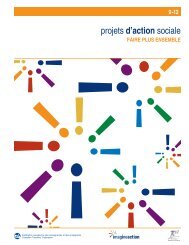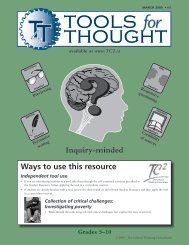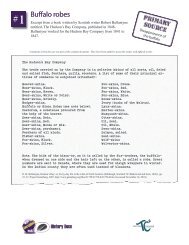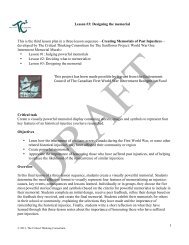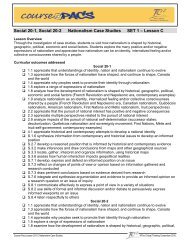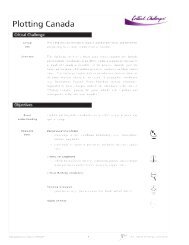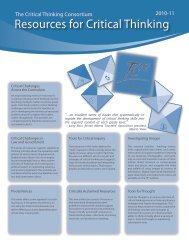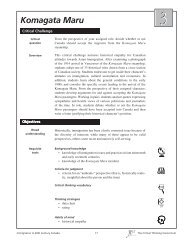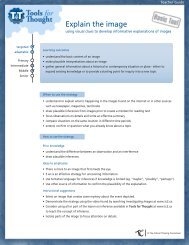Lesson A Introduction to Ultranationalism - The Critical Thinking ...
Lesson A Introduction to Ultranationalism - The Critical Thinking ...
Lesson A Introduction to Ultranationalism - The Critical Thinking ...
You also want an ePaper? Increase the reach of your titles
YUMPU automatically turns print PDFs into web optimized ePapers that Google loves.
2<br />
Students will be assessed on their collages, based on the following criteria:<br />
visuals represent increasing intensity<br />
turning point<br />
explana<strong>to</strong>ry paragraph and/or presentation<br />
visual appeal.<br />
LESSON ACTIVITIES<br />
Teacher preparation<br />
1) Print a class set of student booklets (20-SB3A).<br />
2) Make 20-WL3A digitally available for students <strong>to</strong> access (if necessary).<br />
Legend of symbols<br />
ideas for differentiated instruction<br />
assessment (―for‖ or ―of‖ learning)<br />
EXPLORING ULTRA<br />
Select the superior product<br />
Click on Internet links <strong>to</strong> reveal pictures of three different products—<br />
Clearasil, an ultrathin cell phone and (optional) Michelob beer—in their<br />
regular and ―ultra‖ forms, and ask students <strong>to</strong> vote for the product they<br />
would rather buy.<br />
Justify your choice<br />
Invite students <strong>to</strong> discuss the specific fac<strong>to</strong>rs that make one product better<br />
than another, and invite them <strong>to</strong> write a statement that summarizes their<br />
idea of the prefix ―ultra‖ so far.<br />
COMPARING HISTORICAL EVENTS<br />
Identify similarities and differences<br />
Students choose two events from <strong>to</strong>pic A and two from <strong>to</strong>pic B. As they<br />
explore the events, help students find the fac<strong>to</strong>rs that the two events from<br />
<strong>to</strong>pic A have in common and the fac<strong>to</strong>rs that the two events from <strong>to</strong>pic B<br />
have in common. <strong>The</strong>n challenge students <strong>to</strong> create a list containing the<br />
biggest differences between <strong>to</strong>pics A and B. By the time students complete<br />
this task, they should recognize that the A <strong>to</strong>pics represent nationalism and<br />
the B <strong>to</strong>pics represent ultranationalism.<br />
Define terms and provide examples<br />
Give students an explanation of nationalism <strong>to</strong> copy in<strong>to</strong> their student<br />
booklets, and invite them <strong>to</strong> think of examples with a partner. Next,<br />
students create their own explanations and provide three examples of the<br />
concept of ultranationalism, using the knowledge they have gained so far in<br />
this lesson.<br />
Practise your understanding<br />
Guide students through three linked pages of his<strong>to</strong>rical events (the space<br />
race, World Cup soccer and Japanese internment). After giving students<br />
the information on each page, invite them <strong>to</strong> determine whether the events<br />
are examples of nationalism, ultranationalism or both, explaining their<br />
reasoning using specific detail from the sources provided.<br />
Use the rubric provided <strong>to</strong> assess the classifications. Look for proper<br />
classifications and support in students’ explanations.<br />
SB Page 1 Students circle<br />
their choice of product then<br />
write the <strong>to</strong>tal class votes in<br />
the boxes provided.<br />
Students brains<strong>to</strong>rm ideas,<br />
using the chart provided.<br />
SB Page 2 Students<br />
complete a similarities and<br />
differences chart.<br />
SB Page 2 Students copy<br />
an explanation and create<br />
examples of nationalism.<br />
Students write their own<br />
explanations and examples<br />
of ultranationalism.<br />
SB Page 3 Students check<br />
the box beside their choice<br />
and write their reasons for<br />
each event.<br />
Course-Pacs <strong>Lesson</strong> 20-3A <strong>Introduction</strong> <strong>to</strong> <strong>Ultranationalism</strong> ©<strong>The</strong> <strong>Critical</strong> <strong>Thinking</strong> Consortium 2010



